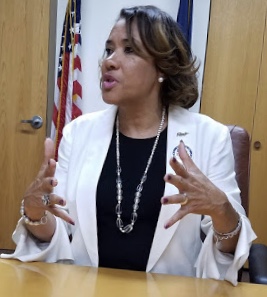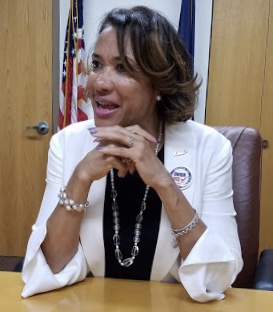By Jan Worth-Nelson
It’s mid-afternoon on a balmy Monday, the first day of autumn, and Flint Mayor Karen Weaver already is running behind. It’s been a demanding and emotional day.
That morning, Weaver had stood next to her police chief, Tim Johnson, flanked by city staff and community religious leaders and said, “Our city is in need of prayer.” The press conference had been hastily called after a bloody weekend left three dead in a triple homicide on the city’s east side.
“This is not right, it’s got to stop,” she declared, in a somber plea for more resources for the city’s youth. “We need to get a message to young people that there are other ways to resolve issues. We’ve already had a water crisis — a generation has suffered and been dam- aged by lead in the water. Some kind of way this city has to come together. There need to be some alternatives to thinking that the only way to resolve things is to kill people.”
Later that day, the mood shifted as she joined in a ribbon cutting for a new Communities First, Inc. apartment complex, the refurbished Coolidge Elementary School, which has been transformed into 54 apartments.
That project is a reflection of both how the city’s schools one by one have been abandoned as enrollments plummeted, and also of how enterprising developers, like Communities First president and CEO Glenn Wilson, who attended Coolidge Elementary as a child, are finding ways to repurpose and rehabilitate some of the city’s beautiful old structures.
In a way, those two events typify the dimensions of Weaver’s turbulent first four years in office: facing down tragedy and the turmoil of the city’s residents as the water crisis hit one of the poorest and most violent cities in the country, and then representing the city as it was thrust into the national spotlight, and then managing the influx — sometimes problematic, demanding and controversial — as that attention triggered millions of dollars of aid, donations and visits from hundreds of outsiders. We are told because of her schedule crunch we have 20 minutes, less than we expected; we negotiated for 30, understanding that we would not get to,all our questions.
She sits down at one end of a long table in her conference room with two EVM reporters. At the other end are Candice Mushatt, her communications director, and Aonie Gilcreast, Weaver’s chief advisor and outreach development liaison.
Gilcreast is an old friend who had served her for the first three years as a volunteer but then was hired officially for a $120,000 salary provided out of a $3 million Kellogg Foundation economic development grant.

Mayor Karen Weaver (Photo by Tom Travis)
“It was overwhelming at times,” Weaver says, reflecting on how she had no “honeymoon” to speak of following the Nov. 2015 election in which she ousted incumbent Dayne Walling, based on her focused campaign promising action on the water crisis. “It’s been nonstop,” she said. “It was exhausting — and it still is.”
But as her mayoral campaign for a second term picks up steam, she’s taking some time to reflect.
“I sometimes use that quote from Ronald Reagan,” she says with a smile: “Are you better off than four years ago?
“Four years ago we still had poisoned water. Four years ago we didn’t have the information to know what we needed. Four years ago we didn’t know how much it would take to make things right.”
“I think we are better off,” she says.
Now, while she still is advocating for more state aid to continue community rehabilitation such as replacing in-home plumbing fixtures possibly damaged by lead, she is relieved that water is testing better.
“And we’ve been able to start building back,” she said, noting that despite bumps in restoration contracting and implementation replacement — just 4,000 homes remain out of close to 28,000 on the original list, she said, and are scheduled to be completed in 2020.
Still, she says she understands trust has been one of the biggest casualties of the crisis. When a reporter says many people still won’t drink out of the tap, she quickly replies, “I’m not telling them to! I hope they’re not drinking out of the tap! Not unless they’ re comfortable, and that’s a choice that they can make.”
A month into her tenure, she declared a state of emergency, part of a strategy to open up state and federal funds. In January of 2016, Gov. Rick Snyder followed suit. Then-president Obama declined to call it a disaster as she had hoped, but designated it an emergency and signed off on $5 million in initial federal funds.
That was the start of multiple processes bringing in millions more from multiple directions — federal and state grants, class action lawsuits, contributions from charities and individuals — for infrastructure and pipeline replacement, children’s services, health care, nutrition, Medicaid supplements, educational support, psychological and trauma-related support, and of course, lots and lots of water.
Some have said the totals approach $1 billion, but she says nailing those totals down is extremely hard to calculate.
She said she honestly doesn’t know how much money has flowed into the city over the years, and pressed on that point, she said, regarding public funds, “You’ll have to ask the state about that — they doled it out.”
She said following the money in state documents has proven flummoxing — with amounts and destinations often buried in hard-to-find and hard-to-specify line items.
Accounting for the philanthropic flood of money has proven equally elusive, she said.
“And when people hear that money has come in, they think it came to City Hall, and it didn’t,” she said. “I don’t know how many ways to say it.” She said she wishes some of the other agencies in town who received donations would be more transparent, so that City Hall “doesn’t have to take the fall” for accountability that she cannot provide.
“If you spent it in a way that’s helpful to the city, talk about it,” she said. “A lot of places got money but have been very quiet.”
On Flint foundations: “I thank them every chance I get”
Regarding the omnipresent influence of philanthropic institutions in the city — the C.S. Mott Foundation, Community Foundation of Greater Flint, the Ruth Mott Foundation, and others — Weaver said, “We can’t do this by ourselves and we shouldn’t do it by ourselves … in Flint, philanthropy has played a big role and I thank them every chance I get.
“When the water crisis hit, they didn’t want to overstep their bounds — we had a conversation about pipes and infrastructure, but that’s not where their money is supposed to go — that’s something the government was supposed to do. But our foundations have been present for us: they’ve been partners.”

(Photo by Tom Travis)
City Council thoughts
Addressing the notorious chaos of the City Council, Weaver said, “I used to go, but it’s exasperating. It’s hard when you send your department heads up there and they get insulted and talked down to. I’ve lost two department heads because of the City Council.
“And eight-hour meetings? We can’t do that.” She said she is asked about the council’s reputation in Washington, Baltimore, Chicago — everywhere she goes. The city may be losing business because of it, she suggests.
“Nobody wants to go through that experience of having to come before them,” she said.
But asked what to do about it, she said, “I don’t know. I can’t be responsible for them. It’s sad for a city that had our voices taken away [during the emergency manager era] and then when we got it back, look what happened.”
On the ombudsperson delays
Asked why the selection of the ombudsperson is taking so long — a position required in the city’s revised charter approved by voters in 2017 and mandated to take effect in January 2018, Weaver said as for the city administration, “We did our part — we did what we were supposed to do,” developing a job description and getting candidates selected — adding she wasn’t sure why HR (human resources) and the new charter-mandated Ethics and Accountability Board haven’t gotten past that. It’s been 640 days as of Oct. 1.
Police and water rates
Asked why there has been no increase in the police budget in the pending city budget, she said simply, “You’ll have to ask the City Council about that.”
Asked if the Great Lakes Water Authority water rates are going up, she quickly answered, “Not for Flint.”
“Exciting” signs
In short, Weaver says, “It’s been non-stop moving the city, making good things happen.”
“You walk around Flint, you see that we’ve made great strides — you see cranes, and contractors working — it’s exciting to see different restaurants; Flint has a fashion industry; we’ve got all of these things happening, entertainment coming into the city — people are buying houses, people want to invest in Flint.
In the meantime, she has clung to several rituals that she says help keep her sane and healthy.
“I pray. I exercise. I listen to loud music,” she says.
“I like so many kinds of music — it shocks people—from Parliament Funkadelic to Tony Bennett. And don’t forget Cher! [who donated 180,000 bottles of water in 2016] Sometimes I play Frank Sinatra singing, ‘I did it my way’ in my car.”
Sometimes, working out in her basement, she says, “I need music with bad words, and sometimes I need a hymn. It all relieves stress.”
Finally, Weaver says, as she gets up and rushes to her next meeting, “Despite everything that we’ve talked about that can seem to be doom and gloom, Flint is a strong city … with strong people, and we don’t let things keep us down.”
EVM Editor Jan Worth-Nelson can be reached at janworth1118@gmail.com.


You must be logged in to post a comment.